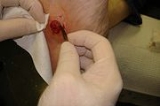
Charcot arthropathy
Encyclopedia
Charcot arthropathy is a progressive
musculoskeletal condition characterized by joint
dislocation
, fractures and deformities. It results in progressive destruction of bone
and soft tissue
of weight-bearing joints, most commonly in the foot
and ankle
. It is most commonly due to diabetes.
of Charcot arthropathy:
Both the neurotraumatic and neurovascular mechanisms are likely to be involved and complement each other. The joint, mechanically weaker due to bone loss is subject to repeated minor injuries, and the patient is unaware of the destruction until the joint is badly damaged.
of acute Charcot arthropathy.
Roughly 75% of patients experience pain, but it is less than what would be expected based on the severity of the clinical and radiographic findings.
Progressive illness
The term progressive illness describes the course of an illness that gradually progresses and changes mode, generally to the worse. In contrast, non-progressive or chronic illnesses are relatively constant.-Examples:...
musculoskeletal condition characterized by joint
Joint
A joint is the location at which two or more bones make contact. They are constructed to allow movement and provide mechanical support, and are classified structurally and functionally.-Classification:...
dislocation
Dislocation
In materials science, a dislocation is a crystallographic defect, or irregularity, within a crystal structure. The presence of dislocations strongly influences many of the properties of materials...
, fractures and deformities. It results in progressive destruction of bone
Bone
Bones are rigid organs that constitute part of the endoskeleton of vertebrates. They support, and protect the various organs of the body, produce red and white blood cells and store minerals. Bone tissue is a type of dense connective tissue...
and soft tissue
Soft tissue
In anatomy, the term soft tissue refers to tissues that connect, support, or surround other structures and organs of the body, not being bone. Soft tissue includes tendons, ligaments, fascia, skin, fibrous tissues, fat, and synovial membranes , and muscles, nerves and blood vessels .It is sometimes...
of weight-bearing joints, most commonly in the foot
Foot
The foot is an anatomical structure found in many vertebrates. It is the terminal portion of a limb which bears weight and allows locomotion. In many animals with feet, the foot is a separate organ at the terminal part of the leg made up of one or more segments or bones, generally including claws...
and ankle
Ankle
The ankle joint is formed where the foot and the leg meet. The ankle, or talocrural joint, is a synovial hinge joint that connects the distal ends of the tibia and fibula in the lower limb with the proximal end of the talus bone in the foot...
. It is most commonly due to diabetes.
Cause
Any condition causing sensory or autonomic neuropathy at a joint can lead to a Charcot deformity.Disease mechanism
Three major theories exist explaining the pathophysiologyPathophysiology
Pathophysiology is the study of the changes of normal mechanical, physical, and biochemical functions, either caused by a disease, or resulting from an abnormal syndrome...
of Charcot arthropathy:
- Neurotraumatic theory (German): A joint without proper sensory innervation is subject to repeated injury. The patient is unaware of minor trauma to the joint and continues to damage it over time.
- Neurovascular theory (French): Loss of sympathetic vascular tone leads to increased blood flow to the joint, causing an imbalance in bone metabolism. Over time the joint becomes osteopenicOsteopeniaOsteopenia is a condition where bone mineral density is lower than normal. It is considered by many doctors to be a precursor to osteoporosis. However, not every person diagnosed with osteopenia will develop osteoporosis...
- Modern theory: A combination of the previous two theories.
Both the neurotraumatic and neurovascular mechanisms are likely to be involved and complement each other. The joint, mechanically weaker due to bone loss is subject to repeated minor injuries, and the patient is unaware of the destruction until the joint is badly damaged.
Symptoms and signs
The clinical presentation varies depending on the stage of the disease from mild swelling to severe swelling and moderate deformity. Inflammation, erythema, pain and increased skin temperature (3-7 degrees celsius) around the joint may be noticeable on examination. X-rays may reveal bone resorption and degenerative changes in the joint. These findings in the presence of intact skin and loss of protective sensation are pathognomonicPathognomonic
Pathognomonic is a term, often used in medicine, that means characteristic for a particular disease. A pathognomonic sign is a particular sign whose presence means that a particular disease is present beyond any doubt...
of acute Charcot arthropathy.
Roughly 75% of patients experience pain, but it is less than what would be expected based on the severity of the clinical and radiographic findings.

